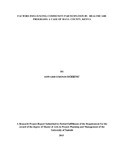| dc.description.abstract | The concept of strengthening community action within the context of disease prevention is
gaining popularity among health cycles. In Kenya for example, key stakeholders in health sector
have recognized the benefits of multi-sectored response to health issues based on partnership
among stakeholders. This study examined the factors influencing community participation in
Kenya with particular reference to healthcare programs in Siaya County. The specific objectives
of the study were: To determine the influence of capacity building on community participation in
healthcare programs in Siaya County, To ascertain the influence of culture on community
participation in healthcare programs in Siaya county, To establish the influence of attitude on
community participation in healthcare programs in Siaya County and To assess the influence of
socio-demographic factors on community participation in healthcare programs in Siaya County.
The study was of significance to the management of healthcare programs in Siaya County, the
government, other stakeholders and the researcher in understanding the factors influencing
community participation in healthcare programs in order to assist in developing regional
strategies and effective policies targeted at improving involvement in governance of healthcare.
The descriptive survey targeted 267 staff across the constituencies of Siaya County. Primary data
was collected through the use of semi-structured questionnaires. Descriptive and inferential
statistics were carried out with SPSS version 20; qualitative data was grouped into themes and
analyzed. Regression analysis was used to determine the strength of association of sociodemographic
factors and level of involvement and contribution of capacity building and culture
to community participation using coefficient of regression (r), level of significance being at 0.05
(P< 0.05) at 95% CI. More males (OR=5.56, 95% CI=3.65-8.63) were involved in decision
making regarding healthcare than their female counterparts (OR= 2.54, 95% CI= 0.54-3.24).
Participants who had more years in education were more likely to participate in the healthcare
programs than those with less education. Capacity building was found to contribute more when
appropriate technology was used (m= 2.111, sd= 0.89499) and when there was adequate
representation of all stakeholders in the process (m= 2.2444, sd= 0.88306). Cultural factors were
the major barriers to community participation. Community involvement and participation in
health programs is key to sustainable development in Siaya County. Strategies should be sought
to address the challenges identified in this study to foster community participation and ownership
of health programs thus improving health services utilization with improved health outcome.
Programs should be locally led and managed by local healthcare professionals, supported and
assisted by community health workers. A comparative study of this study should be carried out
to compare the findings in urban areas. | en_US |



